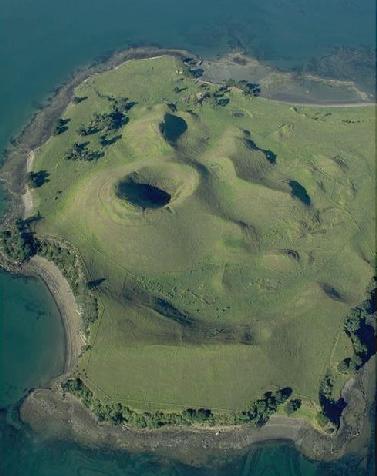Category:Auckland Volcanic Cones
Contents
The Archaeology of Auckland's Volcanic Cones
|
<googlemap lat="-36.825226" lon="174.914017" type="satellite" zoom="11">-36.83347, 174.894791, Motukorea</googlemap> |
Motukorea (Browns Island) has many archaeological features. On this image a pa (fortification) can be seen at the summit and there are two other pa visible. Field boundaries - some historic - can also be seen. Photo: DOC - Kevin Jones. |
The volcanoes within the field include:
- Albert Park
- Ash Hill
- Browns Island, Motukorea
- Crater Hill
- Duders Hill
- Green Hill
- Hampton Park
- Hopua
- Kohuora
- Lake Pupuke
- Little Rangitoto
- Mangere Lagoon
- Mangere Mountain
- Manurewa
- Matakarua
- Maungataketake
- McLennan Hills
- Mt Albert (Owairaka)
- Mount Cambria
- Mount Eden (Mangawhau)
- Mount Hobson (Remuwera)
- Mount Richmond
- Mount Roskill (Puketepapa)
- Mount Saint John
- Mount Smart
- Mount Victoria
- Mount Wellington
- North Head
- One Tree Hill (Maungakiekie)
- Onepoto
- Orakei Basin
- Otara Hill
- Otuataua
- Panmure Basin
- Pigeon Mountain
- Pukaki
- Pukeiti
- Pukekiwiriki
- Puketutu Island
- Rangitoto Island
- Robertson Hill
- Saint Heliers
- Styaks Swamp
- Tank Farm (also known as 'Tuff Crater')
- Taylors Hill
- Te Pouhawaiki
- Three Kings
- Waitomokia
Resources
A key resource for the cones is:
Bulmer, Sue. 1994 Sources for the Archaeology of the Maaori Settlement of the Taamaki Volcanic District. Department of Conservation Science and Research Series No.63. http://www.doc.govt.nz/upload/documents/science-and-technical/S&R63.pdf
Other sources:
Auckland Town Planning Association 1928 Auckland's Unique Heritage. 63 Wonderful Volcanic Cones and Craters. An Appeal to Save Them. 26pp.
Historic Auckland Society, Ed. J Golson, Appendix G M Fowlds 1957 Auckland's Volcanic Cones, A Report on their Condition and a Plea for their Preservation. 32pp.
Fowlds, G M 1967 The Maori Association with the Volcanic Hills and Craters of the Auckland Isthmus. Privately published.
Searle, E J, Janet Davidson 1973 A picture guide to the volcanic cones of Auckland. Auckland Institute and Museum. Auckland, 27pp.
World Heritage Nomination
The Auckland volcanic field is under consideration as a World Heritage Site in the mixed cultural / natural category. The archaeological heritage contributes materialy to the cultural value of this proposal. The process is being run by the Department of Conservation. Their assessment can be read here: DOC assessment.
The World Heritage nomination to the tentative list can be seen here.
The New Zealand Archaeological Association's advocacy for the proposal was as below:
NZAA Advocates World Heritage for the Auckland Volcanic Field
World heritage sites are anointed by UNESCO. In the Pacific they include places like Easter Island, the Galapagos and Royal Exhibition Building in Melbourne. They can be either natural or cultural sites or joint sites which combine both. New Zealand has three sites:
- Tongariro National Park
- Te Wahipounamu - South West New Zealand
- New Zealand Sub-Antarctic Islands
The last two are in the natural category, the first is joint but the cultural side is a traditional importance rather than any human built material. In the rest of the world cultural sites dominate. New Zealand is greatly under-represented in the cultural sites list. New Zealand can nominate one further site at a time. The process is run by the Department of Conservation.
Auckland’s Volcanic Field should be the candidate!
What is Outstanding Here
- Very large and well preserved archaeological sites centred on the cones, from past occupation using them as fortified towns.
- Remains of an extensive landscape of stone fields with gardens and hamlets spread over the landscape around the cones, with Ambury Park and the Otuataua Stonefields exemplifying this.
- An ongoing cultural association between the sites and Iwi. The associations are both local and with a number of groups spread over a wider area of the North Island.
- Cultural practices which continue the association (e.g Matariki on Maungawhau).
- Brown’s Island as a miniature cultural landscape with pa sites, a moa-hunter site, a Maori fish trap traces of Maori gardens, traces of European occupation.
- Modern use of the sites for cultural purposes, defence and servicing the city and port.
- Iconic status to modern Aucklanders of Rangitoto particularly and the other surviving cones.
- Great examples of the volcanic phenomena with explosion craters, tuff rings, lava fields and cratered cones.
- Rangitoto as an example of natural revegetation of a 600 year old volcano.
What Sort of Heritage Area? The nomination should be Joint – cultural and natural. As a volcanic field alone it is not very unusual – the outstanding thing is the use made by people of the cones and the outstanding archaeological landscape that has been left.
What Does Becoming a World Heritage Site Mean
- It will mean the city gains prestige as a place that values and guards its heritage and as a place to visit and stay. If it handles it correctly it could mean more visitor nights.
- It will mean more pressure to manage and protect the sites consistent with their new status.
- It will mean there will be a case for some investment in more and better visitor centres / interpretive centres and on the ground interpretation for the volcanic field.
What should be included: Auckland City: Remuwera (Mt Hobson), Titikopuke (Mt St John), Maungakiekie (One Tree Hill, Maungarei (Mt Wellington), Rangitoto, Panmure Basin, Motukorea (Brown’s Island), Maungawhau (Mt Eden), Owairaka (Mt Albert), Puketapapa (Mt Roskill), Taurere (Taylors Hill), Mt Richmond. North Shore City: Lake Pupuke, Onepoto Lagoons, Mt Victoria, North Head. Manukau City: Otuataua, Mt Mangere, Pigeon Mountain, Ambury Park.
External Links
- Wikipedia Entry on the Auckland Volcanic Field
- Auckland Council Volcanic Fields - Maori Heritage Page
- NZ Herald Feature 15 January 2011 Under the Mountains
Subcategories
This category has only the following subcategory.
